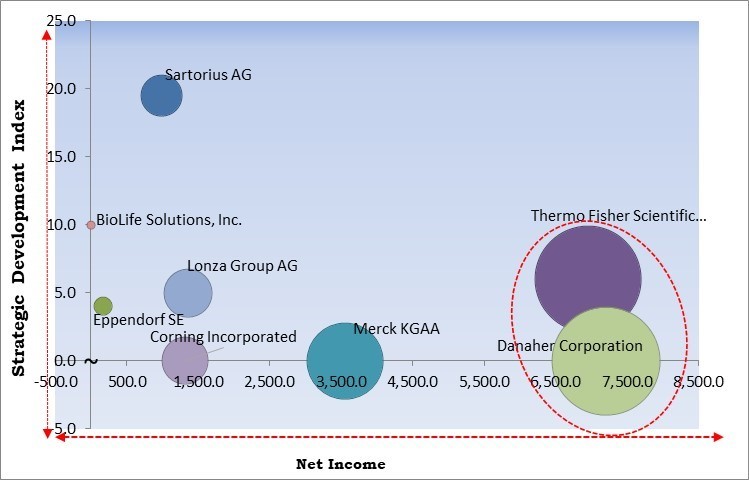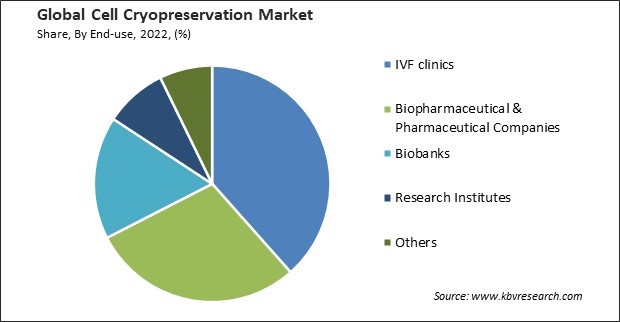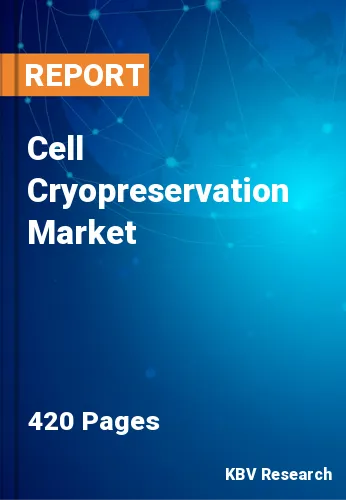The Global Cell Cryopreservation Market size is expected to reach $35.7 billion by 2030, rising at a market growth of 20.3% CAGR during the forecast period.
The surge in stem cell research has led to a growing demand for the banking of various types of stem cells, including embryonic stem cells, induced pluripotent stem cells (iPSCs), and mesenchymal stem cells. Therefore, Stem Cells segment generated $3,228.6 million revenue in the market in 2022. As a result, the increasing focus on stem cell research has driven innovations in cryopreservation techniques specifically tailored to the needs of different stem cell types. These advancements have improved the viability and functionality of cryopreserved stem cells, expanding the capabilities of the market.

The major strategies followed by the market participants are Product Launches as the key developmental strategy to keep pace with the changing demands of end users. For instance, In June, 2023, BioLife Solutions, Inc. unveiled IntelliRate i67C, a new, large-capacity controlled-rate freezer. This launch aimed to fulfill a crucial customer requirement for higher volume production of cell therapies. Moreover, In January, 2021, Lonza Group AG released cryopreserved Leukopaks, an expansion in renowned human primary cell offerings. The launched product would allow long-distance transportation of leukapheresis products without the concern of decreased cell viability encountered with fresh Leukopaks.
Based on the Analysis presented in the KBV Cardinal matrix; Thermo Fisher Scientific Inc and Danaher Corporation are the forerunners in the Market. In August, 2023, Thermo Fisher Scientific Inc. launched the TSV series of laboratory refrigerators and freezers, the Made in India. The launched product would offer controlled temperature technologies including ultra-low temperature freezers and cryopreservation storage tanks that guarantee temperature uniformity and stability, mitigating the risk of sample degradation. Companies such as Sartorius AG, Lonza Group AG and Merck KGAA are some of the key innovators in the Market.

The COVID-19 pandemic had a substantial impact on the market. The pandemic led to a surge in research related to the virus, including the collection and storage of patient samples. This increased demand for cryopreservation services and facilities. The rapid development of COVID-19 vaccines required extensive research and testing. This, in turn, led to an increased need for the preservation of cell lines and materials used in vaccine development. The pandemic highlighted the importance of preparedness for future health crises. Governments and organizations recognized the need for well-equipped biobanking and cryopreservation infrastructure to respond effectively to future outbreaks, which drove investment in these areas. This led to the development of more advanced and efficient cryopreservation techniques and equipment.
The rising interest in egg freezing has increased the demand for cryopreservation services provided by fertility clinics, IVF centers, and reproductive medicine specialists. These facilities require the necessary infrastructure, including cryopreservation equipment and expertise, to offer egg-freezing services. The growing demand for egg freezing has spurred technological advancements in cryopreservation techniques and equipment. These banks are an integral part of the market, and they rely on specialized cryopreservation solutions and equipment to maintain the quality and viability of frozen eggs. The expansion of egg-freezing cycles has contributed to the growth of the market.
The establishment and growth of biobanks worldwide have created a significant demand for cell cryopreservation services. These biobanks rely on cryopreservation techniques to store and preserve diverse biological samples for research and clinical use. Personalized medicine, which tailors medical treatments to individual patients based on their genetics and specific needs, often requires access to well-preserved biological samples. Cryopreserved samples identify genetic markers and biomarkers associated with multiple diseases, drug responses, and treatment outcomes. The increasing number of biobanks and the demand for personalized medicines have expanded the market.
The cost-effectiveness and accessibility of alternative methods can influence their adoption. If alternative methods are more affordable or require less specialized equipment, they may gain popularity in specific contexts. Adopting alternative cryopreservation methods may depend on raising awareness and educating researchers and clinicians about their benefits and proper usage. Validating the effectiveness and safety of alternative methods for cryopreservation can be a complex process. Alternative methods may be integrated with other technologies or approaches, such as microfluidics or 3D bioprinting, which could change the landscape of the cryopreservation market. These factors will decline the market growth in the coming years.
Under consumables type, the market is further segmented into cryogenic vials, cryogenic tubes, cooler boxes/containers, and others. In 2022, the cryogenic vials segment held the highest revenue share in the market. Cryogenic vials are made of materials that are highly resistant to extreme cold, ensuring the preservation of sample integrity. This helps researchers efficiently locate and retrieve specific samples. Cryogenic vials are designed to withstand extreme temperatures and are safe for use in cryogenic environments. They protect researchers and laboratory personnel from exposure to ultra-low temperatures.
Under cell freezing media type, the market is further divided into ethylene glycol, dimethyl sulfoxide, glycerol, and others. In 2022, the ethylene glycol segment registered the highest revenue share in the market. Ethylene glycol acts as a cryoprotective agent by entering the cells and reducing ice crystal formation. This is important for cell survival. The concentration of ethylene glycol in freezing media can change depending on the specific protocol and the preserved cell type. The concentration is carefully chosen to provide effective cryoprotection while minimizing potential toxicity.
Under equipment type, the market is further classified into freezers, incubators, and liquid nitrogen supply tanks. In 2022, the freezers segment generated the largest revenue share in the market. Freezers play a critical role in the market by providing the necessary storage conditions for preserving biological samples, including cells, tissues, and other biological materials, at ultra-low temperatures. They are vital tools in the market, ensuring the long-term preservation of valuable biological materials for scientific and medical advancements.
By end-use, the market is categorised into biopharmaceutical & pharmaceutical companies, research institutes, biobanks, IVF clinics, and others. The biobanks segment garnered a significant revenue share in the market in 2022. Biobanks are critical in the storage and preservation of biological samples, including tissues and cells, for research and clinical applications. According to the National Library of Medicine, economically developed countries had at least 11 biobanks per million people in 2022. Its goal is to simplify the connection of international biobanks, enabling larger and more robust genetic data investigations. This program intends to increase the possibility of detecting novel disease-associated genetic variations by adding more genetic ancestral variety.

On the basis of component, the market is segmented into cell freezing media, equipment, and consumables. In 2022, the consumables segment dominated the market with the maximum revenue share. Cell cryopreservation consumable products are essential in preserving and storing cells and tissues at very low temperatures, typically in liquid nitrogen or ultra-low temperature freezers. This is primarily due to factors such as the increasing adoption of cryovials, cryotubes, and other consumables by end-users due to benefits such as lower contamination. Other aspects, including the rising majority of chronic diseases, growing demand for biologics, and rising demand for cryopreservation among end-users, will propel the segment's growth.
Based on application, the market is fragmented into stem cells, oocytes & embryotic cells, sperm cells, hepatocytes, and others. In 2022, the stem cells segment witnessed the largest revenue share in the market. Stem cell applications rely heavily on cell cryopreservation, which allows stem cells to be preserved, stored, and transported without cellular or genetic change. As per the World Health Federation- 2023 records, over half a billion people worldwide are affected by cardiovascular disorders (CVDs), with around 20.5 million deaths occurring in 2021, accounting for nearly one-third of all deaths globally. The growing senior population, combined with sedentary lifestyles, will raise the burden of cardiovascular disease, fueling the expansion of the segment growth.
| Report Attribute | Details |
|---|---|
| Market size value in 2022 | USD 8.5 Billion |
| Market size forecast in 2030 | USD 35.7 Billion |
| Base Year | 2022 |
| Historical Period | 2019 to 2021 |
| Forecast Period | 2023 to 2030 |
| Revenue Growth Rate | CAGR of 20.3% from 2023 to 2030 |
| Number of Pages | 420 |
| Number of Table | 674 |
| Report coverage | Market Trends, Revenue Estimation and Forecast, Segmentation Analysis, Regional and Country Breakdown, Competitive Landscape, Porter’s 5 Forces Analysis, Company Profiling, Companies Strategic Developments, SWOT Analysis, Winning Imperatives |
| Segments covered | Component, End-use, Application, Region |
| Country scope |
|
| Companies Included | Merck KGaA, Thermo Fisher Scientific, Inc., Sartorius AG, PromoCell GmbH, Lonza Group Ltd., HiMedia Laboratories Pvt. Ltd., Corning Incorporated, BioLife Solutions, Inc., Eppendorf SE and Danaher Corporation |
| Growth Drivers |
|
| Restraints |
|
Region-wise, the market is analysed across North America, Europe, Asia Pacific, and LAMEA. The Asia Pacific region recorded a remarkable revenue share in the market in 2022. Due to the rising adoption of cell cryopreservation technologies in the Asia Pacific region, especially throughout China and Japan. Because of the region's large population, the prevalence of chronic diseases, the rising number of older people, and the surge in the rate of infertility, there is enough scope for expanding the market in the region.
Free Valuable Insights: Global Cell Cryopreservation Market size to reach USD 35.7 Billion by 2030
The market research report covers the analysis of key stake holders of the market. Key companies profiled in the report include Merck KGaA, Thermo Fisher Scientific, Inc., Sartorius AG, PromoCell GmbH, Lonza Group Ltd., HiMedia Laboratories Pvt. Ltd., Corning Incorporated, BioLife Solutions, Inc., Eppendorf SE and Danaher Corporation.
By Component
By End-use
By Application
By Geography
This Market size is expected to reach $35.7 billion by 2030.
Increasing number of egg-freezing cycles are driving the Market in coming years, however, Availability of alternative therapies for cell cryopreservation restraints the growth of the Market.
Merck KGaA, Thermo Fisher Scientific, Inc., Sartorius AG, PromoCell GmbH, Lonza Group Ltd., HiMedia Laboratories Pvt. Ltd., Corning Incorporated, BioLife Solutions, Inc., Eppendorf SE and Danaher Corporation.
The expected CAGR of this Market is 20.3% from 2023 to 2030.
The IVF clinics segment is generating the highest revenue in the Market by End-use in 2022; there by, achieving a market value of $12.5 billion by 2030.
The North America region dominated the Market by Region in 2022 and would continue to be a dominant market till 2030; thereby, achieving a market value of $12.6 billion by 2030.
Our team of dedicated experts can provide you with attractive expansion opportunities for your business.

